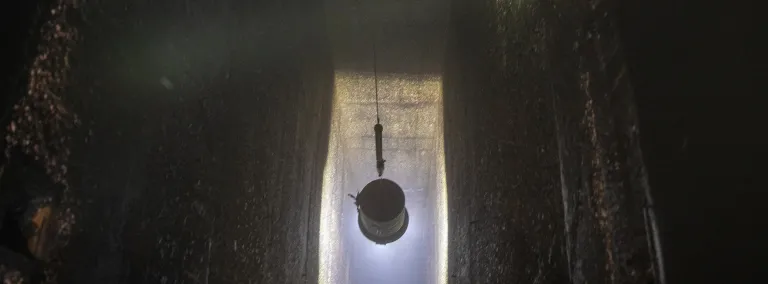Mapping the Oro Hondo Shaft
MVS Capture Unit collects data for a 3-D map detailing the Oro Hondo Shaft—from the surface to the 3800 Level
Workers peered into a thick plume of fog, waiting for a telltale ring of light traveling upward through the Oro Hondo Shaft. Attached to a wire rope cable, an illuminated frame rose through the shaft, carrying a laser sensor that had been designed and outfitted to create a 3-dimensional (3-D) map that will detail the conditions of the shaft from the surface to just above the 3800 Level.
The Oro Hondo Shaft is the main exhaust shaft for Sanford Underground Research Facility’s (Sanford Lab) air circulation system. Forced ventilation from exhaust shaft fans draws fresh air down the Yates and Ross Shafts, which then flows horizontally and vertically through a matrix of underground drifts. The air stream then travels to the surface through two exhaust shafts, the Oro Hondo Shaft and Five Shaft.
“Because the Oro Hondo Shaft is our main exhaust pathway, it is critical we monitor its condition to allow for proper ventilation underground,” said Bryce Pietzyk, underground access director at Sanford Lab.
This shaft, however, poses multiple difficulties for workers attempting to monitor the shaft.
“There are no conveyances in the Oro Hondo Shaft, so our teams can’t ride down the shaft to inspect or to install ground support,” Pietzyk explained. Other obstacles include fog produced by the warm air current traveling through the humid shaft. The fog clouds camera lenses, making visual data difficult to obtain. Additionally, without a guided conveyance, any technology sent down via cable will spin continuously, creating fragmented visuals.
Sanford Lab’s underground access team worked with Randy Deibert of Professional Mapping and Surveying, LLC, and Scott Schiele of Mine Vision Systems to create a solution that could overcome these challenges and give them a good understanding of the Oro Hondo Shaft. They selected a sensor called the Mine Vision Systems Capture Unit (MVS Capture Unit) and constructed a frame to hold its power source and shield it from the rough conditions of the shaft.
The MVS Capture Unit consists of two cameras and a LiDar (Light Detection and Ranging) laser. The sensor was fixed to the bottom of the sturdy frame along with a data collection system, a large battery pack and water shielding. The entire frame was attached to a cable and lowered slowly through the shaft. Over a five-hour period, the frame traveled down the shaft and the sensor captured massive amounts of data. Each camera took fifteen photos per second, while the LiDar laser marked 40,000 laser points per second.
When the sensor was retrieved on the surface, these immense data sets were used to create a 3-D map of the Oro Hondo Shaft.
“The data sets are layered together to give us a detailed, continuous map of the shaft,” said Deibert. “Once the camera’s images are stitched together like a video, we have a visual of the shaft. But the images also serve to orient the laser as it maps the shaft without the aid of a GPS system.”
The first time the team completed this scan was in 2016. The process is repeated each year, and the annual 3-D models are overlaid within their mapping systems. A color-coded schematic reveals the changes that have occurred in the shaft over time.
“This laser-scanning process is necessary for a good understanding of the shaft,” said Pietzyk. “This is our third year. From scan to scan we can tell if there is any spalling (material falling off the walls) underground, where it is coming from and how much material may be accumulating at the bottom of the shaft.”
This particular undertaking has been a proving ground for the MVS Capture Unit. Because of the depth of the shaft, the team could not maintain wireless connection with the data collection system. Not only did the sensor withstand harsh physical conditions, it also produced valuable data from a blind scan.
“After a depth of 300 feet, we would lose all connection with the data collection system. This is the deepest shaft we have ever scanned blind (without a connection). The first scan in 2016 proved a real test for the laser,” said Schiele. “The technology withstood the test and, since then, has been used for many other similar applications worldwide.”
With three years of layered data, Sanford Lab’s underground access team has access to an advanced, detailed map of the Oro Hondo Shaft.
“With the technology from Mine Vision Systems and the support from Sanford Lab employees, the team was able to perform the laser scan safely, while ensuring the air quality remains safe for everyone underground,” Deibert said.
"MVS's ongoing work with Sanford Lab in developing and maintaining a detailed understanding of crucial operational infrastructure and ventilation systems is vital to having a full understanding of daily safety, structural integrity, and operational consistency," said Pete Carney, director of sales for MVS.
